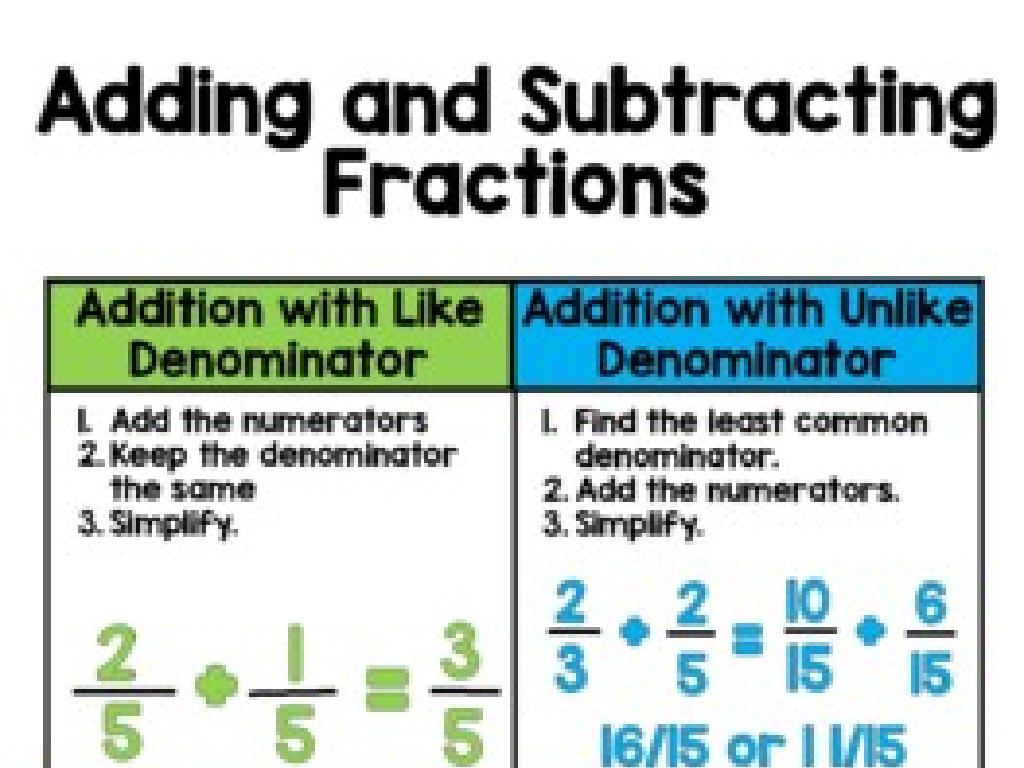Factor Variable Expressions Using The Distributive Property
Subject: Math
Grade: Sixth grade
Topic: Equivalent Expressions
Please LOG IN to download the presentation. Access is available to registered users only.
View More Content
Factoring with Distributive Property
– Understanding equivalent expressions
– Expressions with the same value, even if they look different
– ‘Equivalent’ in math context
– Means ‘equal in value or function’
– Focus: Factoring using distributive property
– Break down expressions into simpler parts
– How it simplifies expressions
– Example: 3(x + 4) is the same as 3x + 12
|
This slide introduces students to the concept of equivalent expressions in mathematics, emphasizing the meaning of ‘equivalent’ as being equal in value or function, despite potentially different appearances. The focus is on teaching students how to factor variable expressions using the distributive property, which is a key skill in simplifying algebraic expressions. By applying this property, students can break down more complex expressions into simpler, equivalent forms. For instance, they can learn to see that 3(x + 4) can be expanded to 3x + 12, and vice versa, understanding that both expressions are equivalent. Encourage students to practice with various examples and to recognize the utility of this property in solving algebraic problems.
Review: The Distributive Property
– Recall distributive property
– a(b + c) = ab + ac, a common algebraic rule
– Multiply term by terms in parenthesis
– Example: 3(x + 4)
– Apply property: 3 times x and 3 times 4
– Simplify to 3x + 12
– Combine like terms: 3x and 12
|
This slide is a review of the distributive property, which is a fundamental concept in algebra. It’s important for students to understand that this property allows them to multiply a single term outside the parenthesis by each term inside the parenthesis. The example 3(x + 4) demonstrates how to apply the distributive property by multiplying 3 by x and then by 4, resulting in 3x + 12. Emphasize that the distributive property helps in simplifying expressions and is essential for solving equations. Encourage students to practice with additional examples and to remember this property as they progress in algebra.
Factoring Variable Expressions
– Factoring: Reverse of distribution
– Identify common factors
– Look for numbers/variables that are in every term
– Example: Factor 2x + 6
– 2x + 6 can be written as 2(x + 3) using the distributive property
– Practice with different expressions
|
This slide introduces the concept of factoring as the reverse process of distribution. Students should understand that factoring involves identifying common factors in variable expressions and expressing them in a simplified form. The example 2x + 6 = 2(x + 3) illustrates how a common factor of 2 is taken out, showing the distributive property in reverse. Encourage students to practice by finding common factors in different expressions and factoring them out. This will help them to recognize patterns and simplify expressions effectively. Provide additional examples and practice problems to reinforce the concept.
The Importance of Factoring Expressions
– Factoring simplifies expressions
– Break down complex expressions into simpler, manageable parts
– Eases the solving of equations
– Solve equations quickly by isolating variables
– Prepares for advanced algebra
– Fundamental skill for understanding future algebraic concepts
|
Factoring is a critical skill in algebra that allows students to simplify complex expressions, making them easier to manage and solve. By breaking down expressions into their constituent factors, students can more easily isolate variables and solve equations. This process not only aids in solving problems more efficiently but also lays the groundwork for understanding more advanced algebraic concepts that they will encounter in higher grades. During the lesson, provide examples of factored expressions and demonstrate how they lead to simpler equations. Encourage students to practice factoring with different variable expressions to gain confidence in this essential skill.
Let’s Practice Together: Factoring Expressions
– Factor 4y + 8 example
– Extract the GCF: 4(y + 2)
– Factor x^2 + 5x example
– GCF is x: x(x + 5)
– Step-by-step walkthrough
– We’ll go through each step to ensure understanding
|
This slide is designed as an interactive class activity to practice factoring expressions using the distributive property. Start with the first example, 4y + 8, and guide the students to identify the greatest common factor (GCF), which is 4 in this case. Show them how to factor out the GCF to write the expression as 4(y + 2). Proceed to the second example, x^2 + 5x, and repeat the process by factoring out the GCF, which is x, resulting in x(x + 5). Encourage the students to follow along and work through the steps on their own or in pairs. After the walkthrough, ask students to share their work and explain the steps they took. This will reinforce their understanding and provide an opportunity for peer learning. Prepare additional similar problems for students who finish early or need extra practice.
Your Turn to Factor!
– Factor 3m + 9
– Take out the common factor of 3: 3(m + 3)
– Factor 6n^2 + 2n
– Common factor is 2n: 2n(3n + 1)
– Work independently or with a partner
– Share your answers with the class
|
This slide is designed as a class activity to practice factoring expressions using the distributive property. Students should identify and factor out the greatest common factor in each expression. For the first problem, the number 3 is the greatest common factor, and for the second problem, it is 2n. Encourage students to work through these problems either on their own or with a partner to foster collaboration. After completing the problems, students should be ready to share their solutions and discuss the steps they took to arrive at their answers. As a teacher, be prepared to guide them through the process if they struggle and to affirm correct reasoning. Possible variations of the activity could include having students create their own expressions to factor or factoring expressions with more than two terms.
Class Activity: Factor Bingo
– Receive your unique Bingo card
– Listen for factored expressions
– Match with unfactored equivalents
– Example: If I say ‘2(x + 3)’, mark ‘2x + 6’ on your card
– Aim for five in a row to win!
|
This activity is designed to help students practice factoring variable expressions using the distributive property in a fun and interactive way. Each student will receive a Bingo card populated with various unfactored expressions. As the teacher, you will call out factored expressions, and students will need to identify and mark the equivalent unfactored expression on their cards. This will require them to apply their understanding of the distributive property to reverse the factored expressions. Prepare a list of factored expressions beforehand and ensure there is a good mix of difficulty levels. Possible variations of the game could include having students work in pairs, offering hints for more challenging expressions, or having a ‘lightning round’ where expressions are called out more rapidly. The first student to align five correct matches in a row, column, or diagonal and call out ‘Bingo!’ wins the game. Have small prizes or extra credit points ready for the winners to keep the game exciting.
Review and Wrap-Up: Factoring Expressions
– Recap of today’s lesson
Reviewed how to factor expressions using distributive property.
– Significance of factoring
Factoring simplifies expressions & solves equations efficiently.
– Homework: Practice factoring
Factor 10 different expressions to reinforce today’s lesson.
– Prepare for next class discussion
|
Today, we learned how to factor variable expressions using the distributive property, which is a key skill in algebra. Understanding factoring is crucial because it allows students to simplify complex expressions and solve equations more easily. For homework, students are assigned to factor 10 different expressions to ensure they practice and grasp the concept. In the next class, we will discuss their solutions and address any difficulties they encountered. This will help solidify their understanding and prepare them for more advanced algebraic operations.





